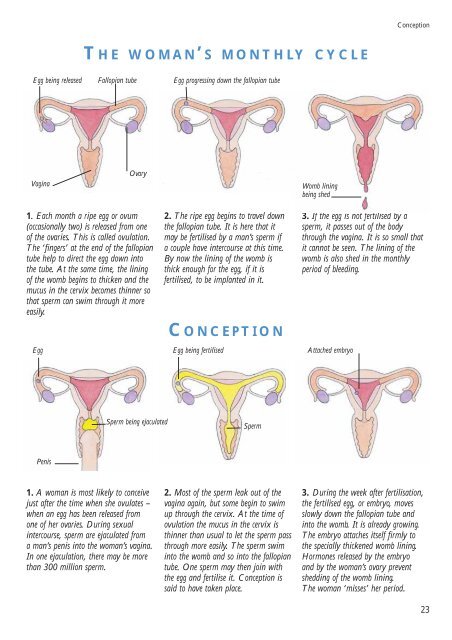here - Health Promotion Agency
here - Health Promotion Agency
here - Health Promotion Agency
Create successful ePaper yourself
Turn your PDF publications into a flip-book with our unique Google optimized e-Paper software.
Conception<br />
T HE WOMAN’ S MONTHLY CYCLE<br />
Egg being released<br />
Fallopian tube<br />
Egg progressing down the fallopian tube<br />
Vagina<br />
Ovary<br />
Womb lining<br />
being shed<br />
1. Each month a ripe egg or ovum<br />
(occasionally two) is released from one<br />
of the ovaries. This is called ovulation.<br />
The ‘fingers’ at the end of the fallopian<br />
tube help to direct the egg down into<br />
the tube. At the same time, the lining<br />
of the womb begins to thicken and the<br />
mucus in the cervix becomes thinner so<br />
that sperm can swim through it more<br />
easily.<br />
Egg<br />
2. The ripe egg begins to travel down<br />
the fallopian tube. It is <strong>here</strong> that it<br />
may be fertilised by a man’s sperm if<br />
a couple have intercourse at this time.<br />
By now the lining of the womb is<br />
thick enough for the egg, if it is<br />
fertilised, to be implanted in it.<br />
C ONCEPTION<br />
Egg being fertilised<br />
3. If the egg is not fertilised by a<br />
sperm, it passes out of the body<br />
through the vagina. It is so small that<br />
it cannot be seen. The lining of the<br />
womb is also shed in the monthly<br />
period of bleeding.<br />
Attached embryo<br />
Sperm being ejaculated<br />
Sperm<br />
Penis<br />
1. A woman is most likely to conceive<br />
just after the time when she ovulates –<br />
when an egg has been released from<br />
one of her ovaries. During sexual<br />
intercourse, sperm are ejaculated from<br />
a man’s penis into the woman’s vagina.<br />
In one ejaculation, t<strong>here</strong> may be more<br />
than 300 million sperm.<br />
2. Most of the sperm leak out of the<br />
vagina again, but some begin to swim<br />
up through the cervix. At the time of<br />
ovulation the mucus in the cervix is<br />
thinner than usual to let the sperm pass<br />
through more easily. The sperm swim<br />
into the womb and so into the fallopian<br />
tube. One sperm may then join with<br />
the egg and fertilise it. Conception is<br />
said to have taken place.<br />
3. During the week after fertilisation,<br />
the fertilised egg, or embryo, moves<br />
slowly down the fallopian tube and<br />
into the womb. It is already growing.<br />
The embryo attaches itself firmly to<br />
the specially thickened womb lining.<br />
Hormones released by the embryo<br />
and by the woman’s ovary prevent<br />
shedding of the womb lining.<br />
The woman ‘misses’ her period.<br />
23
















